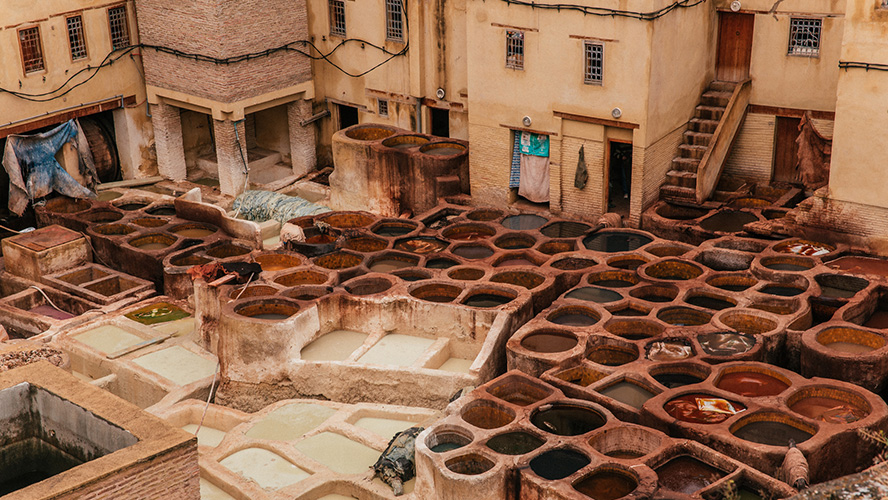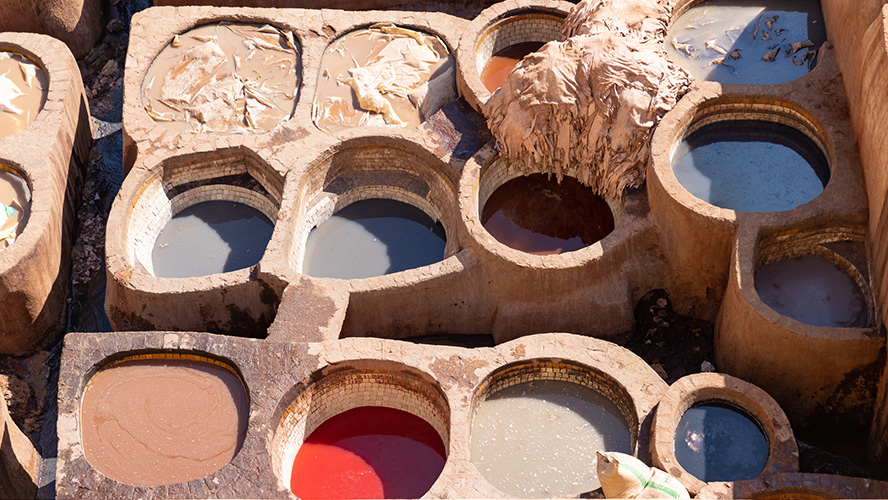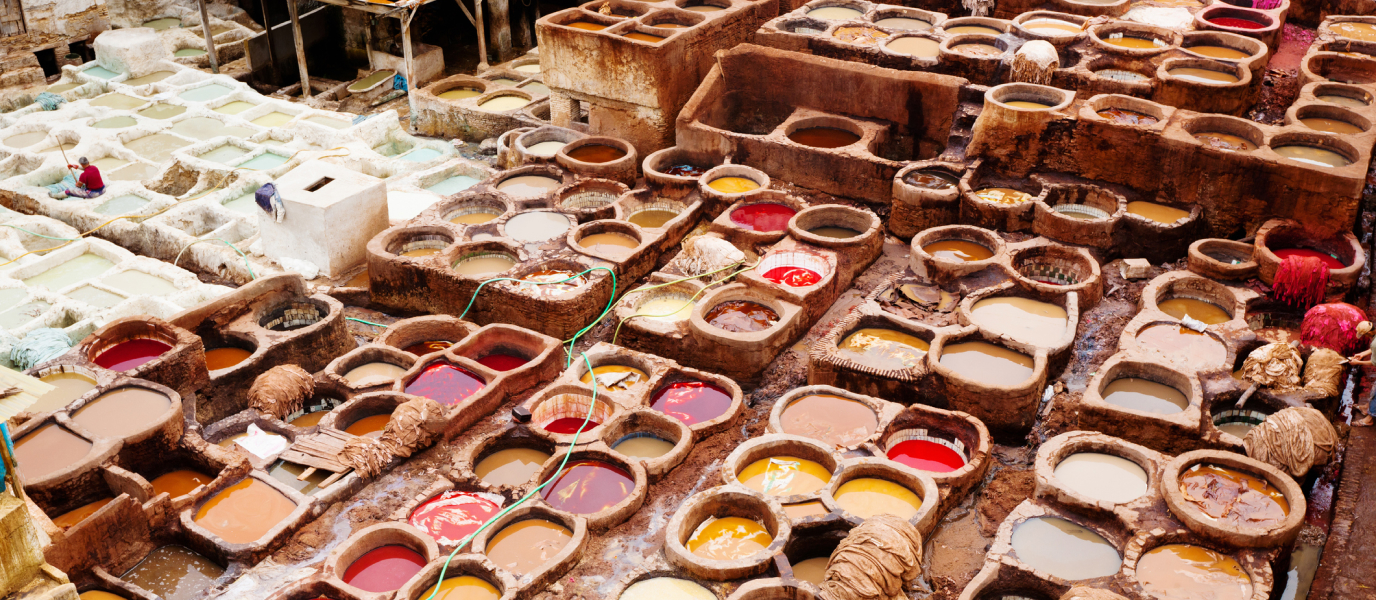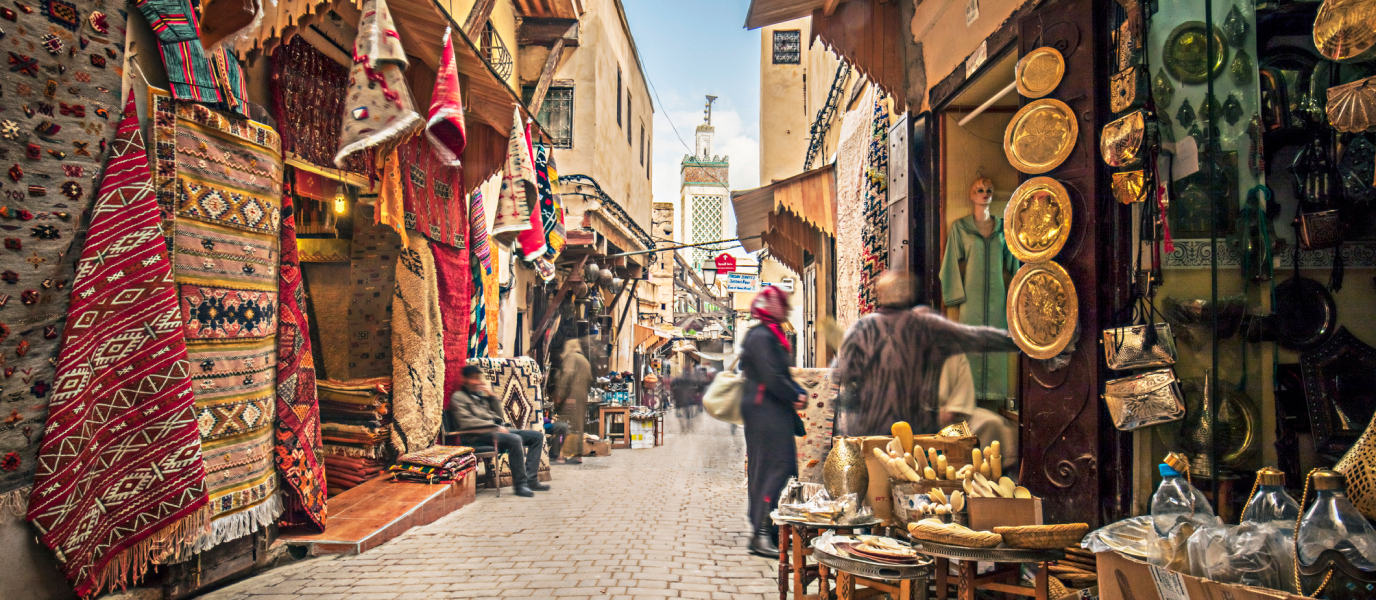It’s an impressive place no matter what time of day you visit. Firstly, because of its size – it’s the largest in Fez – and, secondly, because you’ll breathe in a sense of the long centuries spent making leather entirely by hand on this spot. Unfortunately, that’s not the only thing you’ll breathe in… So don’t turn down the sprig of mint you’re handed at the entrance, it’s essential!
Chouara Tannery: History and meaning
Fez locals say that tanning leather began here when the medina itself was built, back in the 9th century. However, historic remains reveal that the tannery, one of the oldest in Morocco, was actually founded in the 13th century and used water from the Fes River, now practically hidden by a mass of stone vessels.

Either way, the tanners of Fez have almost a thousand years’ experience at drying and preparing goat, camel and cow hides and turning them into any object you can imagine: Moorish slippers, bags, wallets, or pouffes for sitting and resting a while.
The largest artisan industry in Fez takes place among these stone vessels and the process has actually changed very little over the centuries. However, over time, the tanning industry has gradually moved to the outskirts of the medina to prevent the whole old town being affected by the bad smell.
The tanning process
The first thing you’ll see when you visit the tannery is that some stones vessels are white while others are a wide range of incredible terracotta tones. The white vessels are the first to receive the hides after they’ve been dried in salt on the rooftops of the tannery to remove any traces of water.
These white vessels are full of pigeon faeces, ash and cow urine; the hides spend several days soaking in this mixture to remove any impurities and be deep cleaned. Now you’ll understand where the intense smells at Chouara come from…

Once they are clean, the colour and softness of the leather depends on the brown vessels, where the natural dyes that can be seen from nearby roof terraces are mixed with oils and fig paste to give the leather its final texture.
After it is dyed, the leather is hung around the tannery to dry in the sun before being sent directly to the workshops of artisans who use it to create any Moroccan-style object you can imagine.
Visiting Chouara Tannery
You can’t spend a few hours in Fez without visiting a tannery, especially Chouara Tannery. The tanning craft is part of the city on every level: its architecture, economy and culture. That’s why, despite the smell, you mustn’t miss out on seeing the enormous square that houses the tannery and its countless colourful stone vessels.

You can book a private tour that will take you down to the work area and give you a first-hand view of how a cow or goat hide is turned into a valuable piece of reddish or yellow leather. Or, if you’d prefer to keep your distance, you can also admire the tannery from the roof terraces of nearby shops where the process can be enjoyed along with some great views.
Shopping
The area around Chouara Tannery is great for finding anything and everything you can imagine made in leather. One way to see the tannery is to watch the tanning process from the shops that face onto the square. If you do this, you’ll be asked by the shopkeeper to view the items on sale in their shop – most come from the leather produced in this very spot, helping you appreciate how just how hard artisan work is in Fez.
Like in the rest of the city, you have to haggle in these shops when you want to buy something and get the owner to knock down their prices. What’s more, if the seller is a professional, you’ll also get a highly instructive chat about how each of their products was made.
Tips for visiting Chouara Tannery
The square housing Chouara Tannery is a courtyard surrounded by blocks of flats with shops that have views of the craft process from their roof terraces. When you enter the square, sellers will hand you a sprig of mint – it’s essential for seeing the vessels without passing out from the intense smell. The second you head up to a roof terrace, press the mint to your nose – it neutralises the stench of the dyes and faeces used in the tanning process.
When your visit comes to an end, if you’re not going to buy anything, it would be polite to offer the shopkeeper some money for having let you use their terrace to admire the most traditional and colourful show in Fez.
Where to stay in Fez
One of the best accommodation options in Fez is the Barceló Fès Medina, a haven of peace in the heart of the medina that is well-connected to both the airport and the train station.
This new and modern complex has 134 rooms with every comfort that are ready to welcome all types of guest and have been designed to make you feel as though you’re still in the medina.
The hotel also has a hammam with a range of massages, like others in the city, an international restaurant that specialises in Moroccan dishes, and a Jazz Bar, where you can end the day with a fantastic cocktail or relaxing drink. Other facilities include an outdoor swimming pool, essential for the summer months, where you can take a refreshing dip before, during or after your visit.
















































































